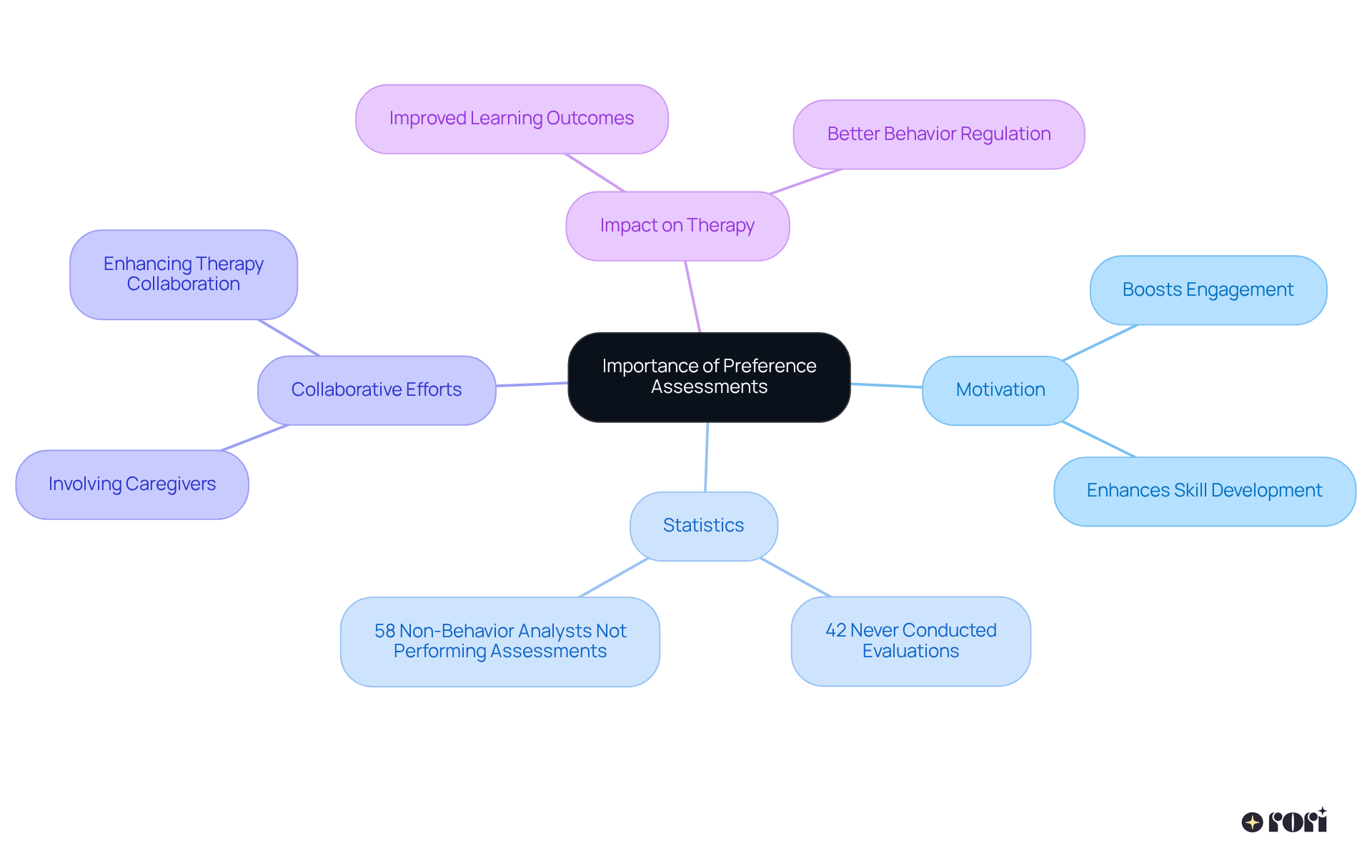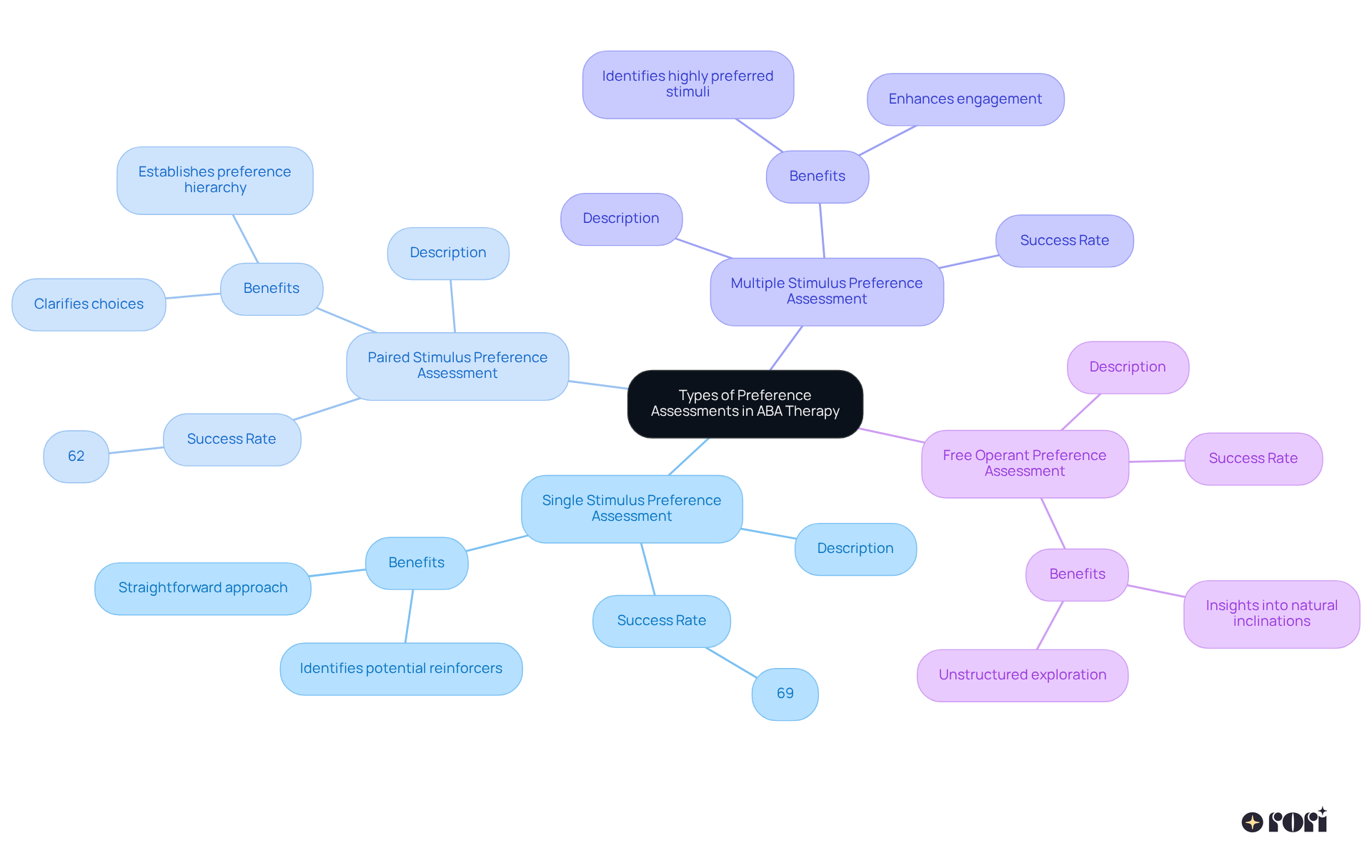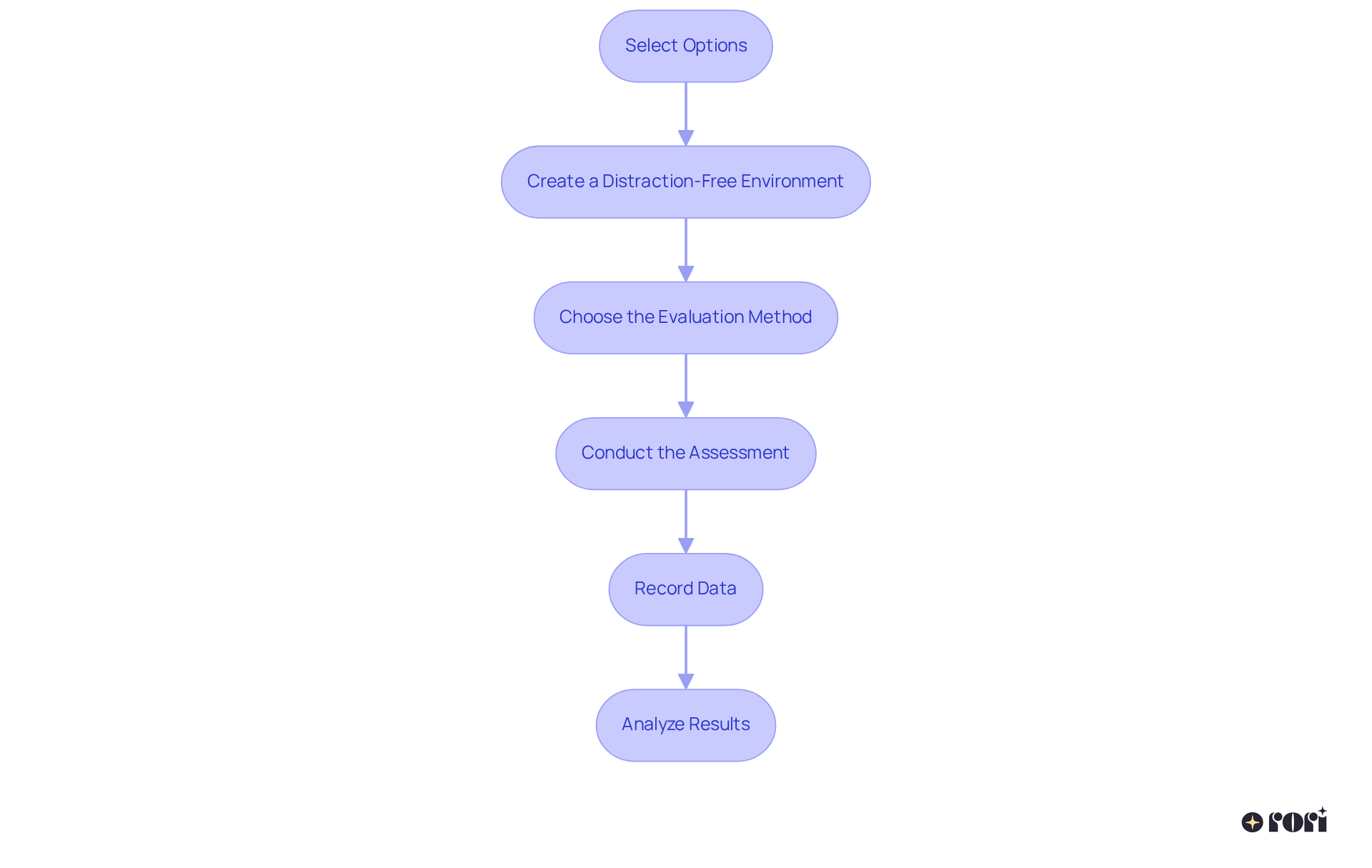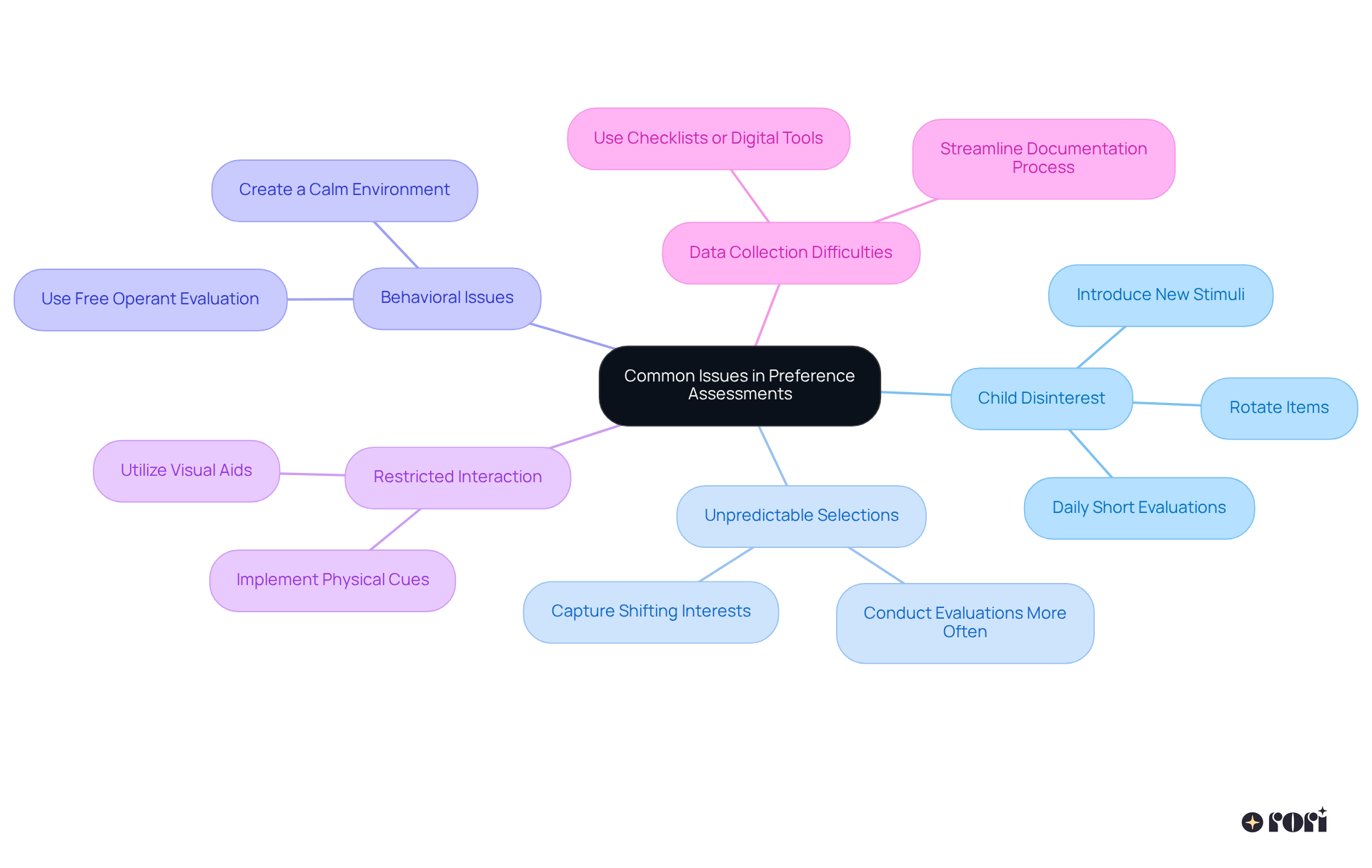This article dives into the steps for effectively implementing RBT preference assessments in Applied Behavior Analysis (ABA) therapy. 😊 It lays out a structured approach that includes:
Each of these steps is essential for tailoring interventions to individual preferences and enhancing therapy outcomes. Let’s explore this together!
In the world of Applied Behavior Analysis (ABA), understanding what motivates our children is crucial for supporting their growth and development. RBT preference assessments are fantastic tools that help us uncover these motivations, allowing therapists to create interventions that truly resonate with each child's unique interests. Yet, despite their many benefits, some practitioners encounter challenges that make it tough to implement these assessments effectively.
So, how can we tackle these obstacles? It’s essential to ensure that every child receives the personalized support they need to thrive. Let’s explore this together! 🌟
RBT preference assessment in Applied Behavior Analysis (ABA) is an organized method that helps us discover what a young person enjoys—be it items, activities, or stimuli. Understanding these preferences through an RBT preference assessment is crucial; it enables professionals to tap into what motivates a child, using these interests as powerful tools to encourage positive behaviors. Did you know that about 89% of BCBAs and BCaBAs report using empirically supported SPA procedures in their work? This statistic really highlights how important these evaluations are in practice!
There are various techniques, like direct observation and structured trials, that therapists can use to conduct RBT preference assessments. This enables them to customize interventions based on each individual’s unique likes and dislikes as determined by the RBT preference assessment. For instance, if a therapist notices a young person engaging more with high-tech toys than with simpler ones, they can weave these preferences into treatment plans, which can significantly boost engagement and effectiveness. As Keith D. Allen wisely points out, "The use of preferred stimuli as contingent reinforcers increases the efficacy of the treatment of problematic behavior compared to the use of arbitrary stimuli."
By conducting an RBT preference assessment to recognize what a child enjoys, therapists can craft more engaging and impactful strategies, ultimately leading to better outcomes in ABA therapy. However, it’s essential to acknowledge some challenges in conducting these evaluations, like limited training or time constraints that professionals might face. Involving families in this process can make a big difference, as their insights can really enhance the effectiveness of choice evaluations.
Let’s explore this together! By working as a team, we can ensure that every child receives the support they need to thrive. We're here to help you every step of the way!

RBT preference assessments are extremely important in ABA therapy! They help uncover what truly motivates a child by conducting an rbt preference assessment, allowing therapists to pick the right reinforcers. Did you know that 42% of participants mentioned they’ve never done comprehensive evaluations? This really highlights the need for regular check-ins to ensure that interventions remain relevant and effective.
When therapists use an rbt preference assessment to identify preferred items or activities, they can boost engagement and motivation during sessions. This is key for helping kids learn better! Interestingly, 58% of nonbehavior analysts also reported not performing these evaluations, which shows a gap in practice that could impact therapy outcomes.
Involving caregivers in these choice evaluations can provide valuable insights into a child’s preferences, enhancing the collaborative aspect of therapy. It’s crucial to conduct rbt preference assessments frequently since young people's likes can change over time. This flexibility keeps kids interested and supports steady progress in therapy.
For instance, research has shown that when therapists conduct an rbt preference assessment, children often show higher levels of engagement. This leads to more successful skill development and better behavior regulation. The role of motivation in ABA therapy is vital; it lays the groundwork for teaching new skills and reducing challenging behaviors.
As James Carr wisely noted, "if professionals do not recognize the significance of even the most basic techniques for evaluating choices, additional information and training may be inadequate to boost SPA utilization." So, let’s make it a priority to incorporate choice evaluations into our regular practice! It’s a simple step that can greatly enhance the effectiveness of ABA therapy. We’re here to help you every step of the way!

In ABA therapy, we use various kinds of rbt preference assessments to determine what truly inspires individuals with autism. Let’s dive into some of these assessments together:
Single Stimulus Preference Assessment: This method involves showing one object to the young person at a time. We closely observe their reactions to gauge interest. It’s a straightforward approach for identifying potential reinforcers. Research shows that this method has a 69% success rate in recognizing individual choices, making it a reliable option for practitioners.
Paired Stimulus Preference Assessment: Here, we present two items at the same time and ask the individual to select one. This simple comparison helps clarify choices and has demonstrated a 62% success rate in identifying what young ones favor. It’s especially effective in establishing a hierarchy of choices, which can guide our reinforcement strategies.
Multiple Stimulus Preference Assessment: This approach showcases various objects simultaneously, allowing the youth to pick their favorite from the collection. There are different variations, including evaluations with and without substitution, which can provide a broader insight into their preferences. This method is efficient and can quickly identify highly preferred stimuli, enhancing engagement in therapy.
Free Operant Preference Assessment: In this setting, the young one freely engages with a range of objects over a specified duration. This unstructured method offers insights into natural inclinations, as they can explore and interact with items without limitations. It’s particularly useful for understanding preferences in a more organic setting.
Each of these techniques has unique benefits and can be chosen based on the individual’s skills and the specific circumstances of the evaluation. By using these systematic approaches, practitioners can effectively tailor interventions informed by the rbt preference assessment that resonate with each child’s unique motivations, ultimately enhancing the outcomes of ABA therapy.
However, it’s important to recognize that 81% of professionals indicate a lack of time as a barrier to carrying out these evaluations, which can hinder their implementation. Involving caregivers during evaluations fosters consistency across settings, ensuring that the insights gained are relevant and applicable in different environments. Plus, regular choice evaluations are crucial to reflect any changes in preferences, as these can evolve over time. As mentioned in the literature, "Regular evaluations are crucial for ascertaining whether selected reinforcers persist in motivating and supporting desired behaviors." By addressing these elements, we can improve the efficacy of choice evaluations in ABA therapy. Let’s explore this together!

To effectively conduct a preference assessment, let’s walk through these essential steps together:
Let’s explore this together and make the most of these assessments for our little ones!

When it comes to conducting rbt preference assessments, practitioners often face a few common hurdles that can really impact how effective the process is. Let’s dive into some of these challenges together!
First up is Child Disinterest. It can be tough when a child shows little interest in the items presented. A great way to tackle this is by rotating the items or introducing new stimuli to spark their engagement. Research suggests that daily short evaluations might elicit better reactions than longer pre-treatment assessments. This highlights how variety can truly boost interest! Plus, a study on regular choice evaluations shows that consistency can lead to better skill acquisition outcomes.
Next, we have Unpredictable Selections. If a child frequently changes their preferences, it might be helpful to conduct evaluations more often. This approach allows practitioners to capture those shifting interests and adjust the evaluation process, ensuring that the chosen reinforcers remain effective. Interestingly, during MSWO evaluations, the mean consensus was found to be an impressive 99.7%, underscoring the reliability of preference evaluations when done regularly.
Another challenge is Behavioral Issues. Sometimes, problematic behaviors can disrupt the evaluation process. It’s essential to create a calm environment, and using a free operant evaluation can help reduce pressure. This way, kids can explore the objects without the stress of making direct choices.
For our non-verbal little ones, Restricted Interaction can pose a challenge. Communication barriers can complicate the evaluation of choices. Utilizing visual aids or physical cues can significantly enhance their ability to express their preferences. For instance, in a case study with Julian, a four-year-old with ASD, visual aids made a world of difference in helping him communicate his choices during evaluations.
Lastly, let’s talk about Data Collection Difficulties. Sometimes, keeping track of data can feel overwhelming. Streamlining the documentation process with handy checklists or digital tools can make data collection smoother, allowing practitioners to monitor choices more accurately.
By anticipating these challenges and implementing targeted strategies, practitioners can greatly improve the effectiveness of rbt preference assessments. This ultimately leads to better therapy outcomes for children with autism. Let’s explore this together and make a difference in their lives!

RBT preference assessments are truly essential in Applied Behavior Analysis (ABA). They help us discover what motivates children, making therapy more engaging and effective. By understanding individual preferences, therapists can create interventions that really resonate with each child, turning therapy into a more enjoyable experience. Plus, regular evaluations and family involvement highlight the need to adapt to changing preferences over time.
Throughout the article, we explored key strategies for implementing preference assessments effectively. We talked about different types of assessments, like single stimulus, paired stimulus, and free operant evaluations. Each method has its own benefits, allowing practitioners to choose the best fit for each child's unique needs. We also addressed common challenges, such as child disinterest and difficulties with data collection, ensuring that the assessment process remains informative and effective.
Ultimately, we can’t stress enough how important thorough and regular RBT preference assessments are. They not only boost engagement and motivation in therapy but also empower caregivers and professionals to collaborate effectively. By prioritizing these assessments, practitioners can significantly enhance the effectiveness of ABA therapy, paving the way for better outcomes and a brighter future for children with autism. Embracing these practices is a vital step toward creating a supportive and responsive therapeutic environment that meets the needs of each child. Let’s explore this together and keep making a difference!
What is an RBT preference assessment in Applied Behavior Analysis (ABA)?
An RBT preference assessment is an organized method used to discover what a young person enjoys, including items, activities, or stimuli. It helps professionals identify what motivates a child, allowing them to use these interests as tools to encourage positive behaviors.
Why are preference assessments important in ABA therapy?
Preference assessments are crucial because they help uncover what truly motivates a child, enabling therapists to select appropriate reinforcers. This boosts engagement and motivation during sessions, which is key for effective learning and skill development.
What techniques are used to conduct RBT preference assessments?
Techniques for conducting RBT preference assessments include direct observation and structured trials. These methods allow therapists to customize interventions based on each individual's unique likes and dislikes.
How can involving families enhance RBT preference assessments?
Involving families can provide valuable insights into a child's preferences, enhancing the collaborative aspect of therapy and improving the effectiveness of choice evaluations.
How often should RBT preference assessments be conducted?
RBT preference assessments should be conducted frequently, as young people's likes can change over time. Regular check-ins ensure that interventions remain relevant and effective.
What challenges might professionals face when conducting preference assessments?
Professionals may encounter challenges such as limited training or time constraints when conducting preference assessments, which can impact the evaluation process.
What impact do preference assessments have on therapy outcomes?
Research shows that when therapists conduct preference assessments, children often exhibit higher levels of engagement, leading to more successful skill development and better behavior regulation in therapy.